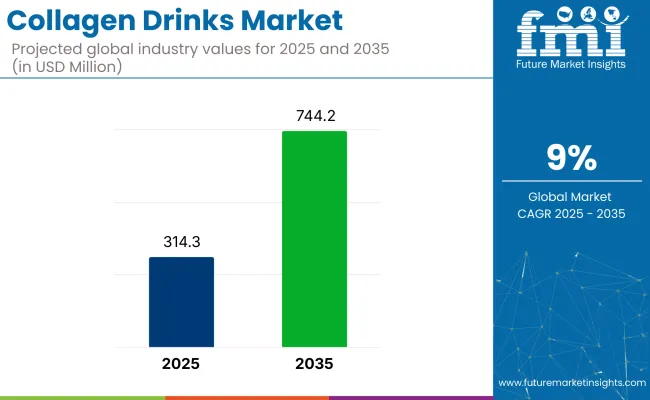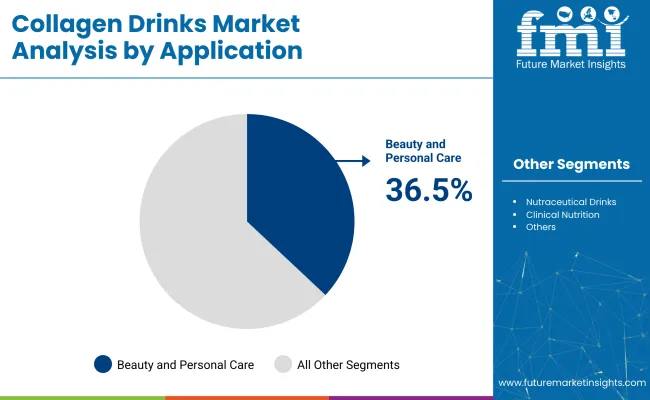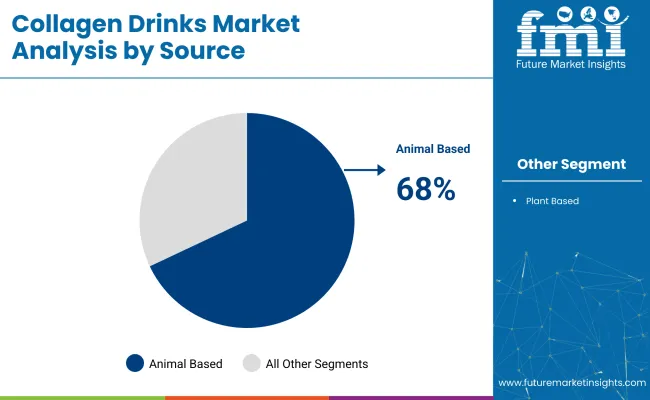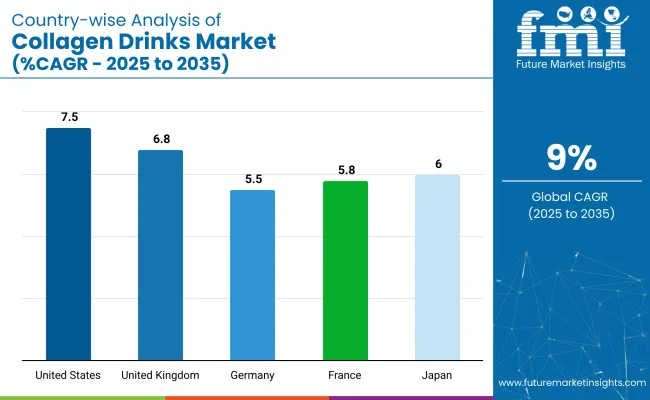The global collagen drinks market is projected to grow from USD 314.3 million in 2025 to USD 744.2 million by 2035, registering a CAGR of 9%. Market expansion is driven by increasing health awareness and rising adoption among millennials and Gen Z, coupled with the popularity of anti-aging beverages. With the rising focus on skin health, joint support, and holistic wellness, collagen drinks are witnessing robust adoption.

| Metric | Value |
|---|---|
| Industry Size (2025E) | USD 314.3 million |
| Industry Value (2035F) | USD 744.2 million |
| CAGR (2025 to 2035) | 9% |
The market holds an approximately 0.2% share of the functional beverages market, reflecting its niche positioning within health drinks. Within the beauty and personal care segment, it commands approximately 0.055%, emphasizing its role in nutricosmetics and beauty-from-within segments. It contributes around 0.08% to the nutraceuticals market, highlighting its relevance in preventive health and dietary supplements. However, in the expansive global food and beverage industry, its share remains minimal at below 0.01%.
Government regulations impacting the market focus on regulatory agencies in the USA, Europe, and Japan to enforce strict guidelines on product labelling, health claims, and safety standards to ensure consumer protection. The European Food Safety Authority (EFSA) mandates approval of functional health claims associated with collagen drinks, ensuring transparency and scientific backing.
In the USA, the FDA monitors ingredient safety under dietary supplement regulations, requiring manufacturers to adhere to Good Manufacturing Practices (GMP). Japan’s FOSHU framework also ensures efficacy and safety of health beverages. These regulations foster market credibility, consumer confidence, and sustained industry growth.
The USA is projected to be the fastest-growing market, expanding at a CAGR of 7.5% from 2025 to 2035. Pharmacy and drug stores will lead the sales channel segment with a 35.6% share, while animal-based collagen drinks will dominate the source segment with a 68% share. The Japanese and German markets are also expected to expand steadily at CAGRs of 6% and 5.5%, respectively.
The collagen drinks market is segmented by end user, application, source, sales channel, and region. By end user, the market is divided into millennials & Gen Z, elderly population, athletes & fitness enthusiasts, pregnant & postpartum women, health-conscious individuals, and others (working professionals, beauty influencers, recovering patients, and corporate wellness participants).
Based on application, the market is categorized into beauty & personal care, nutraceutical drinks, sports nutrition, weight management, clinical nutrition, and other applications (digestive health, bone strength, sleep support, and hair nourishment). By source, the market is bifurcated into plant-based collagen drinks and animal based collagen drinks.
Based on sales channel, the market is classified into modern trade, specialty stores, pharmacy & drug stores, online retail store, and other sales channels (direct-to-consumer platforms, wellness clinics, spas and salons, and vending machines). Regionally, the market is classified into North America, Latin America, Western Europe, Eastern Europe, Balkans & Baltic, Russia & Belarus, Central Asia, East Asia, South Asia & Pacific, and Middle East & Africa.
Millennials and Gen Z are expected to lead the end user segment, capturing approximately 33.6% market share in 2025. Their preference for preventive health and beauty solutions shapes market demand.
Beauty and personal care are projected to lead the application segment, accounting for over 36.5% of the global market share by 2025. Collagen drinks have been used to support skin hydration, elasticity, and appearance enhancement.

Animal based collagen drinks are projected to lead the source segment, accounting for approximately 68% of the global market share in 2025. These drinks are widely adopted due to their established efficacy in supporting skin, joint, and overall health.

Pharmacy and drug stores are anticipated to lead the sales channel segment, holding 35.6% of the global market share in 2025. Their position as trusted outlets for health supplements drives this dominance.
The collagen drinks market has been experiencing steady growth, driven by increasing consumer demand for beauty-enhancing beverages, joint health supplements, and preventive wellness solutions.
Recent Trends in the Collagen Drinks Market
Challenges in the Collagen Drinks Market

Japan leads the collagen drinks market due to increasing use in beauty-focused functional beverages, marine collagen innovations, and cultural acceptance of daily beauty-from-within routines. Germany and France maintain consistent demand driven by nutricosmetics adoption, clean-label trends, and regulatory alignment with EU health and wellness standards. While, developed economies such as the USA (7.5% CAGR), UK (6.8%), and Japan (6%) are expanding at a steady 0.70-0.85x of the global growth rate.
Japan leads in high-purity marine collagen beverages integrated into daily routines for skin hydration and elasticity. Germany and France leverage strong pharmacy networks and beauty supplement markets, where collagen drinks are positioned for skin, hair, and joint health.
The USA market emphasizes nutraceutical-grade formulations distributed through pharmacies and online channels, while the UK focuses on clean-label plant-based alternatives catering to vegan consumers. As the market adds over USD 429.9 million globally by 2035, both beauty-led and health-focused regions will shape long-term demand.
The report covers in-depth analysis of 40+ countries; five top-performing OECD countries are highlighted below.
The Japan collagen drinks revenue is growing at a CAGR of 6% from 2025 to 2035. Growth is driven by cultural integration of collagen beverages into daily diets, particularly marine-based formulations targeting skin hydration.
The sales of collagen drinks in Germany are expanding at an 5.5% CAGR during the forecast period. Growth is driven by high consumer acceptance of nutricosmetic products, with collagen drinks marketed for anti-aging and skin health benefits.
The demand for collagen drinks in France is projected to grow at a 5.8% CAGR during the forecast period. Demand is driven by the rising popularity of nutricosmetics, workplace wellness programs, and national health initiatives supporting preventive nutrition.
The USA collagen drinks market is projected to grow at 7.5% CAGR from 2025 to 2035. The growth is driven by nutraceutical positioning of collagen drinks for joint support, skin health, and general wellness.
The UK collagen drinks revenue is projected to grow at a CAGR of 6.8% from 2025 to 2035. Growth is supported by rising demand for beauty-from-within products, with a notable shift towards plant-based and vegan collagen drinks.
The collagen drinks market is moderately consolidated, with a combination of global leaders and regional firms actively shaping competition. Companies are prioritizing clean-label innovations, science-backed ingredients, and broader access through diverse retail formats including pharmacies, online platforms, and wellness stores. Distribution strategies increasingly focus on health-conscious demographics, leveraging digital marketing and evidence-based claims to build brand equity.
Tier-one players such as Shiseido Company Ltd., Vital Protein LLC, and AmorePacific Corporation are driving growth by developing premium formulations that support skin health, joint mobility, and general wellness. These firms maintain strong operational bases in Asia and North America, using influencer partnerships and category-specific branding to attract millennials and Gen Z.
Meanwhile, regional brands are advancing with plant-based and marine collagen products catering to niche dietary needs such as halal and vegan. Across the board, market leaders are emphasizing clinical efficacy, targeted messaging, and expansion into high-demand consumer segments.
Recent Collagen Drinks Industry News
| Report Attributes | Details |
|---|---|
| Current Total Market Size (2025) | USD 314.3 million |
| Projected Market Size (2035) | USD 744.2 million |
| CAGR (2025 to 2035) | 9% |
| Base Year for Estimation | 2024 |
| Historical Period | 2020 to 2024 |
| Projections Period | 2025 to 2035 |
| Market Analysis Parameters | Revenue in USD million / Volume in liters |
| By Application | Beauty and Personal Care, Nutraceutical Drinks, Sports Nutrition, Weight Management, Clinical Nutrition, and Others (Digestive Health, Bone Strength, Sleep Support, and Hair Nourishment) |
| By End User | Millennials and Gen Z, Elderly Population, Athletes and Fitness Enthusiasts, Pregnant and Postpartum Women, Health-Conscious Individuals, and Others (Working Professionals, Beauty Influencers, Recovering Patients, and Corporate Wellness Participants) |
| By Source | Plant Based Collagen Drinks and Animal Based Collagen Drinks |
| By Sales Channel | Modern Trade, Specialty Stores, Pharmacy and Drug Stores, Online Retail Store, Other Sales Channels (Direct-T o-Consumer Platforms, Wellness Clinics, Spas a nd Salons, Vending Machines) |
| Regions Covered | North America, Latin America, Western Europe, Eastern Europe, East Asia, South Asia Pacific, Middle East and Africa |
| Countries Covered | United States, Canada, United Kingdom, Germany, France, China, Japan, South Korea, Brazil, Australia |
| Key Players | Shiseido Company Ltd., Vital Protein LLC, AmorePacific Corporation, The Protein Drinks Co., Sappe Public Company Ltd., Asertism Healthcare, Hangzhou Nutrition Biotechnology Co. Ltd., Anveva Nutraceuticals Ltd., Kinohimitsu, Bottles Science Ltd., Bauer Nutrition, Lacka Foods Ltd., Revive Collagen, Heivy, The Collagen Company |
| Additional Attributes | Dollar sales by equipment type, share by power, regional demand growth, policy influence, automation trends, competitive benchmarking |
As per end user, the industry has been categorized into Millennials and Gen Z, Elderly Population, Athletes and Fitness Enthusiasts, Pregnant & Postpartum Women, Health-Conscious Individuals and Others.
As per Application, the industry has been categorized into Beauty and Personal Care, Nutraceutical Drinks, Sports Nutrition, Weight Management, Clinical Nutrition and Others Applications.
This segment is further categorized into Plant Based Collagen Drinks and Animal Based Collagen Drinks.
As per sales channel, the industry has been categorized into Modern Trade, Specialty Stores, Pharmacy and Drug Stores, Online Retail Store and Other Sales Channels.
Industry analysis has been carried out in key countries of North America, Western Europe, Eastern Europe, Russia & Belarus, Balkan & Baltic Countries, Latin America, Central Asia, East Asia, Middle East & Africa and South Asia & Pacific.
The market is expected to reach USD 744.2 million by 2035.
The market is projected to expand at a CAGR of 9% during this period.
Beauty and personal care is expected to lead with a 36.5% market share in 2025.
Animal based collagen drinks are expected to hold approximately 68% of the market share in 2025.
The USA is anticipated to be the fastest-growing market, with a CAGR of 7.5% from 2025 to 2035.






Our Research Products

The "Full Research Suite" delivers actionable market intel, deep dives on markets or technologies, so clients act faster, cut risk, and unlock growth.

The Leaderboard benchmarks and ranks top vendors, classifying them as Established Leaders, Leading Challengers, or Disruptors & Challengers.

Locates where complements amplify value and substitutes erode it, forecasting net impact by horizon

We deliver granular, decision-grade intel: market sizing, 5-year forecasts, pricing, adoption, usage, revenue, and operational KPIs—plus competitor tracking, regulation, and value chains—across 60 countries broadly.

Spot the shifts before they hit your P&L. We track inflection points, adoption curves, pricing moves, and ecosystem plays to show where demand is heading, why it is changing, and what to do next across high-growth markets and disruptive tech

Real-time reads of user behavior. We track shifting priorities, perceptions of today’s and next-gen services, and provider experience, then pace how fast tech moves from trial to adoption, blending buyer, consumer, and channel inputs with social signals (#WhySwitch, #UX).

Partner with our analyst team to build a custom report designed around your business priorities. From analysing market trends to assessing competitors or crafting bespoke datasets, we tailor insights to your needs.
Supplier Intelligence
Discovery & Profiling
Capacity & Footprint
Performance & Risk
Compliance & Governance
Commercial Readiness
Who Supplies Whom
Scorecards & Shortlists
Playbooks & Docs
Category Intelligence
Definition & Scope
Demand & Use Cases
Cost Drivers
Market Structure
Supply Chain Map
Trade & Policy
Operating Norms
Deliverables
Buyer Intelligence
Account Basics
Spend & Scope
Procurement Model
Vendor Requirements
Terms & Policies
Entry Strategy
Pain Points & Triggers
Outputs
Pricing Analysis
Benchmarks
Trends
Should-Cost
Indexation
Landed Cost
Commercial Terms
Deliverables
Brand Analysis
Positioning & Value Prop
Share & Presence
Customer Evidence
Go-to-Market
Digital & Reputation
Compliance & Trust
KPIs & Gaps
Outputs
Full Research Suite comprises of:
Market outlook & trends analysis
Interviews & case studies
Strategic recommendations
Vendor profiles & capabilities analysis
5-year forecasts
8 regions and 60+ country-level data splits
Market segment data splits
12 months of continuous data updates
DELIVERED AS:
PDF EXCEL ONLINE
Collagen Supplement Market Size and Share Forecast Outlook 2025 to 2035
Collagen Water Market Forecast and Outlook 2025 to 2035
Collagen Skin Matrix Market Size and Share Forecast Outlook 2025 to 2035
Collagen-Boosting Biomimetic Peptides Market Size and Share Forecast Outlook 2025 to 2035
Collagen Market Size and Share Forecast Outlook 2025 to 2035
Collagen Peptide Market Analysis - Size, Growth, and Forecast 2025 to 2035
Examining Market Share Trends in the Collagen Casings Industry
Collagen Derivatives Market Analysis by Source, Dosage Form and Application Through 2035
Market Share Insights for Collagen Peptide Providers
Collagen Gummy Market Analysis by Flavor Type, Source, Functionality, Sales Channel and Region through 2035
Collagen Hydrolysates Market Analysis - Size, Share, and Forecast 2024 to 2034
Collagen Casings Market Analysis - Product Type & End Use Trends
UK Collagen Peptide Market Analysis – Size, Share & Forecast 2025–2035
UK Collagen Casings Market Insights – Demand, Size & Industry Trends 2025–2035
Pet Collagen Treats Market Analysis - Size and Share Forecast Outlook 2025 to 2035
Pro Collagen Ingredient Market Analysis – Size, Share, and Forecast Outlook 2025 to 2035
USA Collagen Casings Market Analysis – Size, Share & Forecast 2025–2035
Atelocollagen Market Forecast and Outlook 2025 to 2035
Fish Collagen Market Analysis - Size, Share, and Forecast Outlook 2025 to 2035
Fish Collagen Peptides Market Analysis by Source, Application and Region Through 2035

Thank you!
You will receive an email from our Business Development Manager. Please be sure to check your SPAM/JUNK folder too.
Chat With
MaRIA